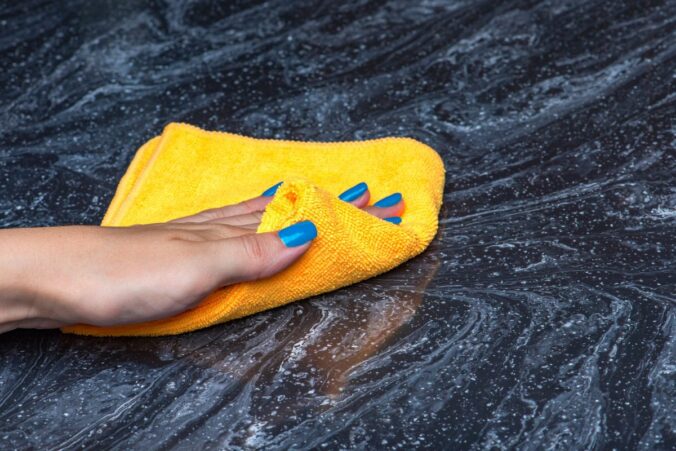Table of Contents
Welcome to the world of headstone cleaning! If you’re new to this, don’t worry, you’re in good hands. Cleaning headstones might sound like a daunting task, but with the right tools and techniques, (and of course these headstone-cleaning tips) it can be a breeze.
Headstones, also known as gravestones or tombstones, are markers placed at the head of a grave to commemorate the life of a loved one. They serve as a lasting tribute and a symbol of remembrance.
Keeping cemetery markers clean and well-maintained is an important way to honor the memory of those who have passed away. After all, there is nothing worse than visiting someone who you loved in life and finding a cemetery full of overgrowth or dirty grave markers.
By keeping your loved one’s headstone clean you are not only saying that you didn’t forget them but are also helping to keep the cemetery looking its best. And who knows, you might just create a desire that will make everyone want to clean up the cemetery.
But why bother going through the process to clean a headstone in the first place? Well, for starters, it just looks better.
A clean stone shows that someone still cares about the person who is buried there and wants to keep their memory from life alive. It also helps preserve the stone so that future generations can continue to visit and pay their respects.
In this article, we’ll be going over the best solution to clean the dirty stone and the best ways to clean headstones as well. We’ll cover everything from what headstone cleaner you’ll need to how to remove different types of stains (with and without cleaners).
We’ll also give you some tips for preserving gravestones so that they last for years to come.
So, let’s get started! First things first, you’ll need to gather your supplies. Check out this list of recommended cleaning supplies to make sure you have everything you need.
Trust us, you don’t want to be halfway through cleaning a gravestone and run into a cleaning issue since you’re missing something important!
What You Need Before You Start Cleaning Gravestones
Alright, now that we’ve got the introductions out of the way, it’s time to get down to business. Before you start cleaning gravestones, there are a few things you’ll need to have on hand.
Trust us, you don’t want to be running to the store in the middle of a cleaning session!
Cleaning Supplies
First up, you’ll need some supplies to clean with. You don’t need to break the bank, but you do want to make sure you have the right stuff. Here’s a list of what you’ll need:
- Soft brush (we recommend this one)
- Damp cloth
- Mild soap
- Clean water
- Vinegar
- Baking soda
- Lemon juice
- Hydrogen peroxide
- Cornstarch (if you’re cleaning an older gravestone)
Personal Protective Equipment
Next, you’ll want to make sure you’re protected while you clean. Headstones can be dirty and full of who-knows-what, so it’s important to take precautions. You’ll need:
- Gloves (to protect your hands from dirt and grime)
- Mask (to protect your face and lungs from dust and other particles)
- Eye protection (to protect your eyes from splashes and sprays)
Determine the Type of Headstone Material
Finally, it’s important to know what type of stone you’re you want to clean. Different gravestones are made from different materials, and each material requires a different approach when you clean them. Some common headstone materials include:
- Marble
- Granite
- Sandstone
- Limestone
- Slate
Knowing what material your gravestone is made from will help you determine the best method to clean them that you will want to use. It will also help you avoid using cleaners to clean it which could damage the stone.
So, there you have it! Everything you need to get started with cleaning gravestones. Make sure you have all your supplies on hand and you’re ready to go. In the next section, we’ll talk about preparing the gravestone for cleaning. Stay tuned!
Preparing To Clean The Headstone
Alright, you’ve got your supplies and you’re ready to go. The next step is to get the stone ready for cleaning. This is a crucial step, so pay attention!
Removing Debris and Loose Dirt
The first thing you’ll want to do is remove any debris and loose dirt from the gravestone. This can be done with a soft brush or a damp cloth.
Just gently brush away any leaves, twigs, or other debris that might be on the gravestone. If there’s any loose dirt, wipe it away with a damp cloth.
Wetting the Headstone Surface
Once you’ve removed the debris, you’ll want to wet the stone surface. This will help to loosen any dirt or grime that might be stuck to the headstone.
Just use a damp cloth or a spray bottle filled with clean water to wet the stone.
Identifying and Protecting Surrounding Plants and Flowers
Before you start cleaning, you’ll want to make sure you don’t damage any plants or flowers that might be growing around the headstone. These plants and flowers are often placed there by loved ones to show that they still care, so it’s important to be careful.
If you’re not sure what plants are growing around the stone, just take a moment to look and identify them. Then, use cloth or paper to protect the plants and flowers while you clean.
And that’s it! You’re now ready to start cleaning the stone. In the next section, we’ll talk about gentle cleaning techniques that you can use.
Gentle Cleaning Techniques
Alright, you’ve got the headstone prepared and you’re ready to start cleaning. But wait, what cleaning techniques should you use? Don’t worry, we’ve got you covered.
When it comes to cleaning gravestones, you want to use gentle techniques that won’t damage the stone. You don’t want to scrub too hard and risk scratching the surface, or use harsh chemicals that could cause discoloration or other damage.
Here are a few gentle cleaning techniques that you can use:
Using a Soft Brush
A soft brush is a great tool for removing dirt and grime from the stone. Just use gentle, circular motions to scrub the headstone. Be sure to use a soft brush, like this one, so you don’t damage the stone surface.
Wiping with a Damp Cloth
A damp cloth is another great tool for cleaning gravestones. You can use it to wipe away dirt, grime, and other debris.
Just make sure the cloth is only damp, not soaking wet, so you don’t damage the headstone.
Using Mild Soap and Clean Water
If the stone is particularly dirty, you can use a mixture of mild soap and water to clean it. Just make sure the soap is mild and free of harsh chemicals, like this one. Apply the soap to the stone, then use a soft brush or a damp cloth to scrub the surface.
Avoiding Abrasive Cleaning Materials
It’s important to avoid using abrasive cleaning materials, like steel wool or sandpaper, when cleaning gravestones. These materials can scratch the surface of the stone and cause permanent damage.
Stick to using soft brushes, damp cloths, and mild soap for best results.
And that’s it! These are the gentle cleaning techniques that you can use to clean gravestones. With a little elbow grease and the right tools, you’ll have that headstone looking as good as new in no time.
In the next section, we’ll talk about removing mildew and mold from headstones.
Getting Mildew and Mold Cleaned
Alright, you’ve got the stone cleaned and you’re ready to take on the next challenge: mildew and mold! These pesky growths can be unsightly and can even cause damage to the headstone if left untreated.
But don’t worry, we’ve got some tips for removing them.
Understanding What Causes Mildew and Mold
Before we talk about removing mildew and mold, let’s talk about what causes them. Mildew and mold thrive in moist, warm environments, so it’s no surprise that they often grow on gravestones.
This can happen when rain or other moisture gets trapped on the stone and doesn’t dry quickly enough.
Using a Mixture of Water and Vinegar
One of the best ways to remove mildew and mold is by using a mixture of water and vinegar. The acidic nature of vinegar helps to kill the mildew and mold, while the water helps to rinse it away.
To use this method, mix equal parts water and vinegar in a spray bottle, then spray the mixture onto the affected areas of the stone. Let it sit for a few minutes, then use a soft brush or a damp cloth to scrub the surface.
Using a Mixture of Water and Baking Soda
Another effective method for removing mildew and mold is by using a mixture of water and baking soda. Baking soda is a gentle, abrasive substance that can help to scrub away the mildew and mold.
To use this method, mix a paste of water and baking soda, then apply the paste to the affected areas of the stone. Let it sit for a few minutes, then use a soft brush or a damp cloth to scrub the surface.
Avoiding Harsh Chemicals
It’s important to avoid using harsh chemicals, like bleach, when removing mildew and mold from gravestones. These chemicals can cause damage to the stone surface and may even make the problem worse.
Stick to using natural, gentle remedies like vinegar and baking soda for the best results.
And there you have it! With these tips, you’ll be able to remove mildew and mold from gravestones in no time. In the next section, we’ll talk about removing stains from headstones.
Removing Stains
Stains can be a real pain, especially when they’re on a headstone. But don’t worry, we’ve got some tips for removing different types of stains.
Understanding the Type of Stain
Before you start trying to remove a stain, it’s important to understand what type of stain it is. Different types of stains require different cleaning methods, so it’s important to know what you’re dealing with.
Some common types of stains on headstones include:
- Rust stains
- Mold stains
- Organic stains (like leaves or twigs)
- Water stains
Using a Mixture of Lemon Juice and Salt
Lemon juice and salt make a great combination for removing rust stains from gravestones. The acid in the lemon juice helps to dissolve the rust, while the salt helps to scrub it away.
To use this method, mix lemon juice and salt to make a paste, then apply the paste to the rust stain. Let it sit for a few minutes, then use a soft brush or a damp cloth to scrub the surface.
Using Hydrogen Peroxide
Hydrogen peroxide is a great cleaning solution for removing mold and organic stains from headstones. To use this method, simply apply hydrogen peroxide directly to the affected area and let it sit for a few minutes.
Then, use a soft brush or a damp cloth to scrub the surface.
Using Cornstarch
Cornstarch can be a helpful tool for removing water stains from gravestones. To use this method, simply mix cornstarch and water to make a paste, then apply the paste to the affected area.
Let it sit for a few hours, then use a soft brush or a damp cloth to scrub the surface.
And there you have it! With these tips, you’ll be able to remove different types of stains from headstones. In the next section, we’ll talk about preserving gravestones so that they last for years to come.
Cleaning Older Headstones
Cleaning older headstones can be a bit trickier than cleaning newer ones. These gravestones may be more delicate and may have more stains and damage.
But don’t worry, we’ve got some tips for cleaning older headstones.
Understanding the Material
Before you start cleaning an older stone, it’s important to understand what material it’s made of. Different types of gravestones require different cleaning methods, so it’s important to know what you’re dealing with.
Some common types of headstones include:
- Marble headstones
- Granite headstones
- Sandstone headstones
- Limestone headstones
Consulting with a Professional
If you’re not sure how to clean an older headstone, it’s best to consult with a professional. A professional conservator will be able to advise you on the best cleaning methods for your headstone and will be able to help you avoid damaging the stone.
Using Gentle Cleaning Methods
When cleaning older gravestones, it’s important to use gentle cleaning methods. Avoid using harsh chemicals or abrasive cleaning materials, as these can cause damage to the stone.
Some people will use cleaners like bleach, vinegar, or even Windex glass cleaner to clean a headstone but that isn’t always the best option. Many times these harsh cleaners will do more damage than good if you don’t know what you are doing.
Instead, stick to using gentle cleaning methods like soft brushes, damp cloths, and mild soap.
Protecting the Stone from Future Damage
After you’ve cleaned the stone, it’s important to protect it from future damage. This can be done by regularly cleaning the headstone, avoiding exposure to harsh chemicals, and covering the stone with a tarp or other protective covering during inclement weather.
And there you have it! With these tips, you’ll be able to clean older headstones with care and protect them from future damage. With a little elbow grease and the right tools, you’ll have that headstone looking as good as new in no time.
In the next section, we’ll talk about preserving gravestones so that they last for years to come. Let’s get to it!
Protecting Headstones After Cleaning
You’ve done all the hard work, you’ve cleaned the headstone and it’s looking great. But now it’s time to protect it so that it stays looking great for years to come.
Here are some tips for protecting headstones after you clean them.
Avoiding Exposure to Harsh Chemicals
One of the best ways to protect headstones is by avoiding exposure to harsh chemicals. This includes chemicals found in headstone cleaners, as well as chemicals found in the environment, like acid rain.
To protect the headstone, try to keep it covered with a tarp or other protective covering during inclement weather.
Regular Cleaning
Regular cleaning is another great way to protect headstones. When you clean the headstone on a regular basis, you can remove dirt and grime before it has a chance to cause damage.
This will help to keep the headstone looking great for years to come.
Sealing the Headstone
Sealing the headstone is another great way to protect it. Sealing the headstone will help to prevent moisture from penetrating the surface, which can cause damage over time.
There are many different types of sealers available, like this one, so be sure to choose one that’s appropriate for the type of headstone you have. If you aren’t sure which one is best for the type of stone that you have be sure to read the product instruction pamphlet to ensure it will work for your stone type.
Maintaining Proper Drainage
Finally, it’s important to maintain proper drainage around the headstone. This will help to prevent moisture from accumulating around the headstone, which can cause damage over time.
Make sure the ground around the headstone is sloped away from the headstone and that there is proper drainage in place.
And there you have it! With these tips, you’ll be able to protect your headstone so that it stays looking great for years to come.
Going through the process to clean a headstone can be a bit of work, but it’s well worth it when you see the end result.
Conclusion
Well, folks, we’ve come to the end of our journey on headstone cleaning tips. We’ve covered everything from what you need before you start to clean, to preparing the headstone for cleaning, to removing mildew and mold, to removing stains, to how to clean older headstones, and finally, to protecting headstones after you clean them.
We hope that this article has been informative and helpful. Cleaning headstones can be a bit of work, but it’s well worth it when you see the end result.
Not only will your marker look great, but you’ll be preserving a piece of history and paying respect to those who have gone before us.
So, grab your cleaning supplies, put on some music, and get to work! And remember, if you have any questions or need help, don’t hesitate to consult with a professional. They’ll be able to advise you on the best methods for cleaning your headstone and help you avoid damaging it.
Thanks for reading and happy cleaning!



Leave a Reply